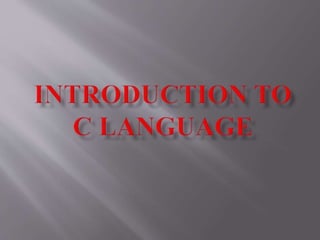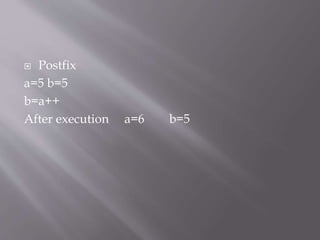Introduction to c
- 2.  C is Programming Language  Developed at AT & T’s Bell Laboratory in 1972  Designed and Written by Dennis Ritchie  Replaced more familiar language like PL/I, ALGOL etc.  Reliable, Simple and easy to use.
- 3. ÔÇß Nobody can learn directly C++/ Java directly ÔÇß C++, C# or JAVA make use of object oriented programming to organize program ÔÇß Major parts of popular OS like windows, Linux are still written in C ÔÇß Common consumer devices like microwave ovens, washing machines and digital cameras program part is written in C ÔÇß Some of 3D computer games
- 6.  VARIABLES • Variables is entity that may change • Variable is nothing but the name given to the memory cell  CONSTANTS • Constant is an entity that doesn’t change
- 7.  KEYWORDS • “Reserved Words” • Keywords are the words whose meaning has already been explained to the C Compiler • Keywords cannot be used as variable names. • 32 Keyword available in C.
- 9. ÔÇ® Constant can be declared in the way we declare variable ÔÇ® But during declaration value need to be assigned to declared contant name. Its value cannot be modifeid in the program ÔÇ® In another way, Constant is nothing but the value that we assign to variable.
- 11. ÔÇ® An integer constant must have atleast one digit ÔÇ® It must not have decimal point ÔÇ® It can be either positive or negative ÔÇ® If no sign precedes an integer constant, it is assumed to be positive ÔÇ® No commas or blanks are allowed within an integer constant ÔÇ® The allowable range for integer constant is -32768 to 32767 (assuming 16bit Compiler)
- 12. ÔÇ® An integer constant must have atleast one digit ÔÇ® It must have decimal point ÔÇ® It can be either positive or negative ÔÇ® Default sign is positive. ÔÇ® No commas or blanks are allowed within an integer constant
- 13. ÔÇ® The mantissa part and exponent part should be separated by a letter e or E ÔÇ® The mantissa part can be positive or negative ÔÇ® Default sign for mantissa is positive ÔÇ® The exponent part must have atleast one digit which must be a positive or negative integer. Default sign is positive
- 14. ÔÇ® Any single alphabet, single digit or a single special symbol enclosed within single inverted commas. ÔÇ® Both inverted commas should point to left
- 15. ÔÇ® Variable name is any combination of 1 to 31 alphabets, digits or underscores. ÔÇ® The first character in the variable name must be an alphabet or underscore ÔÇ® No commas or blanks are allowed within variable name ÔÇ® No special symbol other than an underscore
- 16. ÔÇ® C compiler expects from user to specify type of variable user want to use in program ÔÇ® This declaration is done at the beginning of program ÔÇ® Eg. int a, float akc, char code
- 17.  Different types of data allowed to be used in C language  Primary data types are o Integer o Float o Character  Some modifiers are allowed in C which gives multiple sub class of data types  Such modifiers are like long, short, signed, unsigned, double, long double etc..
- 18. ÔÉò Character occupies 1 byte memory location ÔÇ® Example for character variable declaration ÔÇ® Signed character (Range is -128 to 127) ÔÇ® Unsigned character (Range is 0 to 255) ÔÇ® Format specifier is %c.
- 19. For 16 bit compiler 2^16=65536 So Range is -32768 to +32767 For 32 bit compiler 2^32=4294967296 So range is -2147483648 to 2147483648
- 20. ÔÇ® Integer ÔÇ® Long ÔÇ® Short ÔÇ® Unsigned ÔÇ® Signed For 16 bit compiler Int a; (2byte) a= 32800 Will not work as it is above 32767
- 21. long int a; (4byte) a= 32800 Will work as it is falls in the range of -2147483648 to 2147483648
- 23. ÔÇ® Float occupies 4bytes in memory -3.4e38 to +3.4e38 (6 digits after decimal point) ÔÇ® Double occupies 8bytes in memory -1.7e308 to +1.7e308 (12 digits after decimal point) ÔÇ® Long double occupies 10bytes in memory -1.7e4932 to +1.7e4932 (19 digits after decimal point)
- 24. DATA TYPE SIZE RANGE FORMAT SPECIFIER int 4byte -2147483648 to 2147483647 %d unsigned int 4byte 0 to 4294967296 %u long int/long 4byte -2147483648 to 2147483647 %ld unsigned long int 4byte 0 to 4294967296 %lu long long int 8byte -9223372036854775808 To -9223372036854775807 %lld short int/short 2byte -32768 to 32767 %hd unsigned short int 2 byte 0 to 65535 %hu float 4byte -3.4e38 to 3.4e38 %f double 8byte -1.7e308 to 1.7e308 %lf long double 12 byte -1.7e4932 to 1.7e4932 %Lf char 1byte -128 to 127 %c unsigned char 1byte 0 to 255 %c
- 25.  Assignment Operators = is an assignment operator • a=15 • a=b=c=15 • a+=15
- 26.  Auto Increment/ Decrement Operators These operators are ‘++’, ‘--’, • The operator ++ adds 1 • The operator –– subtracts 1 • Two types: Prefix and Postfix auto increment/decrement • Prefix a=5 b=5 b=++a After Execution a=6 b=6
- 27. ÔÇ® Postfix a=5 b=5 b=a++ After execution a=6 b=5
- 28. ÔÇ® + addition ÔÇ® - subtraction ÔÇ® * Multiplication ÔÇ® / division ÔÇ® % modulo
- 29. ÔÇ® == Checks if values of two operands are equal or not. If yes then condition becomes true ÔÇ® != Checks if values of two operands are equal or not. If no then condition becomes true ÔÇ® > Checks value of left operand is more than right operand. If yes then condition is true
- 30. ÔÇ® < Checks whether right operand is more than left operand. If yes then condition is true. ÔÇ® >= ÔÇ® <=
- 31.  AND &&  OR ||  NOT ! • AND and OR operators allow two or more conditions to be combined in if statement. • Not operator reverses the result of an expression it operates on. The output is logical value i.e. 0 or 1.
- 32.  AND &  OR |  1’s complement operator ~  XOR operator ^  Left shift operator <<  Right shift operator >>
- 33. ÔÇ® Also called as Ternary Operator (?:) Max=a>b?a:b
- 34. ÔÇ® One Expression may contain different operators ÔÇ® Precedence means the order in which the operations are carried out for given expression. ÔÇ® Associativity comes into picture when operators of same priority comes into expression.
- 35. Hierarchy of Operators ! Logical Not * / % Arithmetic and modulus + - Arithmetic < > <= >= Relational == != Relational && Logical AND || Logical OR = Assignment
- 36. printf(“Text to printed on output screen”); e.g. printf(“WELCOME to DKTE”); printf(“Text with format specifier”, variable list); e.g. printf(“year is %d”, y); printf(“Text with format specifier”, expression); e.g. printf(“addition is %d”, a+4);
- 37.  scanf(“format specifier”, list of variable address);  E.g scanf(“%d”,&a); scanf(“%c”,&d);
- 40. if (condition/expression) { statement1; stetement2; …….. }  If only one statement present, then there is no need of curly bracket. But though they are present there won’t be an error.
- 41. if (condition/expression) { statement1; statement2; ……. } else { Statement1; Statement2; …. }
- 42. if(condition/expression) { statement1; ……. } elseif(condition/expression) { statement1; …….} elseif(condition/expression) {statement1; ……}
- 46.  Syntax do { statement1; Statement2;…………………… } while(condition);
- 47.  Syntax for (initial counter; test counter; increment counter) { statement1; statement2;…. }
- 48. switch(integer expression) { case constant1: statement; case constant2: statement; case constant3: statement; default: statement; }
- 49. switch(integer expression) { case constant1: statement; break; case constant2: statement; break; case constant3: statement; break; default: statement; }
- 51.  Array is a collective name given to group of memory location containing similar data types.  Array is a collection of similar elements.  Similar elements could be all int, or all float or all char, etc.  Array of character is called as ‘string’.
- 52. int marks[30] int salary[6]= {24,45,56,56,56,76} int salary[]= {24,45,56,56,56,76}
Editor's Notes
- #14: Ult



















































![int marks[30]
int salary[6]= {24,45,56,56,56,76}
int salary[]= {24,45,56,56,56,76}](https://image.slidesharecdn.com/introductiontoc-170713055017/85/Introduction-to-c-52-320.jpg)